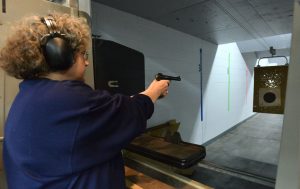
While gun violence in the US has been covered widely in the media in recent years, surprisingly little attention has been paid to the critical role of gender in both its causes and impacts. For example, 88 percent of US homicides are committed by men, who are almost twice as likely to be gun owners than women, despite extensive marketing by the NRA and gun manufacturers towards women. Our colleagues at the Gender Policy Report recently published a robust set of features on “Guns and Gender in America,” enlisting an interdisciplinary group of experts to summarize and reflect on existing research on the topic These pieces together demonstrate the particularly gendered dimensions of gun violence, and also call for considering other intersecting identities like race and class to fully grasp this problem and its potential solutions.
Men are socialized to perform a “male protector” role in order to be seen as “real men.” This may be contributing to the problem of gun violence, especially as there’s been a significant increase in perceived links between protection and guns in recent years. When Texas recently passed a campus carry law, male gun owners embraced this “male protector” role, offering to use their guns to protect female colleagues. Researchers from the Campus Carry Research Team found that the presence of guns on campus, for example, seem to heighten unequal power relations and threaten LGBTQ+ people and women of color, as reported in the second article below.
- Craig Rood. Addressing Gun Violence by Reimagining Masculinity and Protection.
- Patricia Somers. Gender, Power, and Campus Carry.
There is also a learned association between masculinity, guns, and aggression which frequently underlies gun-related intimate partner homicides. These homicides are on the rise in recent years and women are three times more likely than men to be victims.
- James Alan Fox & Emma E. Fridel. Love and Violent Death.
Though deaths from gun violence are well-documented, these authors claim that greater attention should be paid to the trauma children experience from exposure to gun violence. They call for more institutional support in coping for the children most vulnerable to this trauma, which is amplified by gender, sexuality, race, and socioeconomic status.
- Leslie J. Harris & Anna Harris. What the Threat of Gun Violence Has Taught a Generation of American Children.
Together, these pieces make the case that anyone who wants to understand and reduce gun violence must consider the role of gender, as well as intersecting identities like race and class, to fully grasp the causes of gun violence as well as potential solutions.
